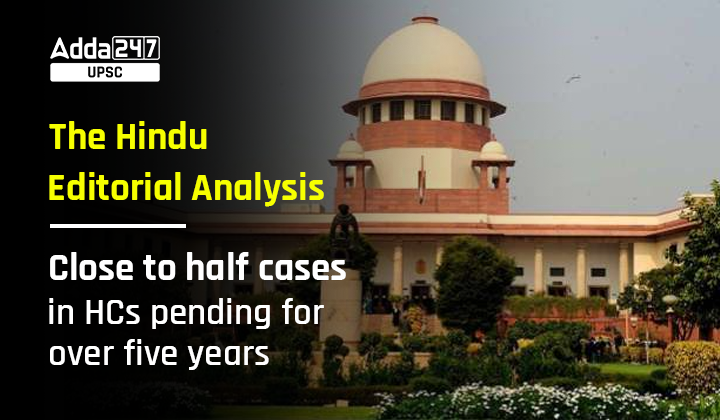Table of Contents
The Hindu Editorial Analysis: The editorial analysis of The Hindu Newspaper Editorial Articles aimed at simplifying various concepts relevant to the UPSC and other State PSC Exams. The Editorial Analysis helps in expanding the knowledge base as well as framing better quality mains answers. Today’s Hindu Editorial Analysis of ‘Close to half cases in HCs pending for over five years’ tries to clear various aspects of rising cases pendency in Indian High Courts.
Pending Cases in High Courts in News
As per recently released India Justice Report 2022, roughly half of the cases in Indian High Courts have been pending for more than five years as of 2nd January 2023.
Status of Pendency of Cases in Indian High Courts
According to the India Justice Report 2022, more than 63% of cases were pending for over five years in the Allahabad High Court (Uttar Pradesh) and Calcutta High Court (West Bengal and A&N Islands). On the other hand, the High Courts in northeastern India such as Tripura, Sikkim, and Meghalaya had less than 10% of cases pending for over five years.
Why Cases Pendency is Increasing in Indian High Courts?
The backlog of cases in courts can be attributed to an issue of demand and supply.
Rising number of Cases
While the number of cases being filed in courts is on the rise every year, the number of judges overseeing these cases remains stagnant or does not increase proportionately to match the increase in cases.
- In fact, the total count of active cases across different High Courts has escalated from over 41 lakh in 2014 to 53 lakh in 2022.
High Judicial Vacancy in High Courts
As of December 2022, High Courts across major Indian states had several unfilled judge positions.
- The percentage of vacancies varied, ranging from a minimum of 16% in Jharkhand to a maximum of 48% in Rajasthan, indicating an insufficient number of judges available.
- In Gujarat, Madhya Pradesh, and Rajasthan, more than 40% of High Court judge positions remained vacant as of December 2022.
- In total, the judicial vacancy rate in Indian High Courts stood at 29.8%, while High Court staff vacancies were at 25.6%.
Impact of Supply-Demand Gap
As a result of this demand-supply mismatch, the clearance rate of cases in High Courts has been adversely affected.
- In cases where the courts are unable to resolve more than 100 out of every 100 cases they receive, the shortfall leads to a backlog, which in turn adds to their pending caseload.
Tracking Performance of Indian High Courts
The case clearance rate is determined by calculating the number of cases disposed of in a year against the number of cases filed in that same year.
Clearance Rate in Indian High Courts
In India, out of every 100 cases filed in 2022, only 95 were resolved that same year, resulting in a clearance rate of 95%, while the remaining 5% were added to the backlog. However, the clearance rate was lower during the pandemic years, with 83% in 2021 and 77% in 2020.
- Last year, the Rajasthan High Court had the lowest clearance rate among all High Courts, with only 65% of cases being resolved in 2022.
- Among major states, the Madras High Court was exceptional, with a clearance rate of over 90% even during the pandemic years, which improved to 107% in 2022.
Tracking Case Clearance Rate against Judicial Vacancies
High Courts in Gujarat, Rajasthan, Himachal Pradesh, and Madhya Pradesh, which had a judge vacancy rate of over 40%, had clearance rates of around 80% or less. In contrast, even though Tripura and Manipur had relatively high vacancy rates (>40%), their clearance rates were over 100%, likely due to a lower influx of fresh cases.
- In some courts, the vacancy rate was relatively lower, yet the clearance rate remained poor.
- For instance, Maharashtra and Tamil Nadu had similar vacancy rates, but there was a significant difference in their clearance rates.
- This variation could be attributed to differences in the volume of incoming cases.
Cases Pendency per High Court Judge in India
While Analysing data on the average number of cases pending per High Court judge in 2017 and 2022, it was found that-
- In Rajasthan, the combination of an extremely high judge vacancy rate and poor clearance rate resulted in each High Court judge having around 24,000 pending cases by 2022.
- This was a significant increase from just over 7,000 pending cases per judge in 2017.
Conclusion
Promptly filling judicial vacancies is essential, but it is also important to explore alternative dispute resolution mechanisms as a means of reducing the burden on Indian Judicial System, especially the high courts.
Editorial Analysis: How to Deal With Pendency of Court Cases?
Editorial Analysis: How to Deal With Pendency of Court Cases?



 TSPSC Group 1 Question Paper 2024, Downl...
TSPSC Group 1 Question Paper 2024, Downl...
 TSPSC Group 1 Answer key 2024 Out, Downl...
TSPSC Group 1 Answer key 2024 Out, Downl...
 UPSC Prelims 2024 Question Paper, Downlo...
UPSC Prelims 2024 Question Paper, Downlo...





